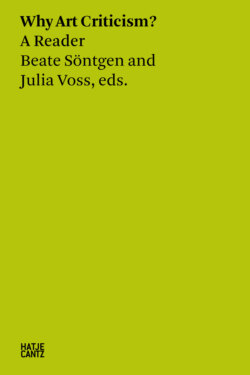Читать книгу Why Art Criticism? A Reader - Группа авторов - Страница 14
Оглавлениеfrom Entwicklungsgeschichte der Modernen Kunst: vergleichende Betrachtungen der bildenden Künste, als Beitrag zu einer neuen Aesthetik, (Modern Art: being a contribution to a new system of aesthetics), 1904
I. Le Déjeuner sur l’herbe (The Luncheon on the Grass)
Each of us has often sat resting in the forest, and this memory ensures our trust in Manet.
… Outside, under trees, two friends and a girl sit together, chatting with each other. One speaks; the others dream. Nothing in particular occurs, but the girl happens to be nude. No one notices, as the conversation and the musings of the listeners drift elsewhere. The situation appears so natural that it would not even require a second girl, who is seen in the background emerging from a swim. The scene is serious, simple, and perfectly appropriate. The very thing that we expect least in this motif is present in overflowing abundance—dignity. A severe, masculine, and very rational dignity that gains its beauty precisely from those elements that seemingly strive against it. Again and again, we perceive anew the mystery, the contradiction of this effect, even if we believe we know the painting as well as an intimate friend. Improvised like all our leisure, a picnic somewhere in the woods becomes a poignant symbol. Two men from a nearby town, a nude girl, nothing more; everything else in the painting is too much. And this absence of legend inspires awe. We tread lightly, keeping a pious distance, not speaking. As if this idyll were a legend of saints.…
The functions of the idyll were love, dance, song, enchantment. This severe, entirely masculine, wholly rational dignity does not belong to prior notions of an idyll, being entirely removed from ecstasy. Manet’s idyll is ours. None of its forms would be conceivable at any other time; certainly not the idea of painting them. This idyll, beside the others, is sober and cold and born of an incomparably more heated devotion. Here, the arousal that renders the old idyll into charming forms seems to be held together in the heart of the painting and hardly cracks a smile. Being, as it is, at the highest point of arousal, it is very cold. Be silent, be silent! it says; see, see! And it is odd how one is silent and descends into sight, and how the quietude becomes greater than all earlier idylls. Momentum, in the painting having been brought to standstill, only ignites exuberance within us, and it is as if joyful spirits who once dwelled in the woods, river gods and satyrs, were performing jubilant dances while we gaze as motionless and indifferent as the three in the painting.…
It is the idyll to which improvisation belongs as a necessary gesture because it cannot bear a pose: our idyll. We can only ever arrive at celebration with improvisations, gaining tranquil moments from so many forms of turmoil. Our idyll’s possibilities lie in the conversational lulls of our addiction, in trembling glances that grasp at serendipitous peace, in flowing trivialities that only a sensation familiar to chance, transcending the ephemeral, is able to hold fast; that is, to preserve them in chance form. They seldom become real: our world is devilishly un-idyllic. But should it succeed, no price is too high. The plainest serenity then becomes a monumental gesture, and a Le Déjeuner sur l’herbe becomes classic on an entirely different magnitude to a Raphaelist engraving of Marc Antony with the river gods….
Edouard Manet, Le Déjeuner sur l’herbe (The Luncheon on the Grass), 1863
